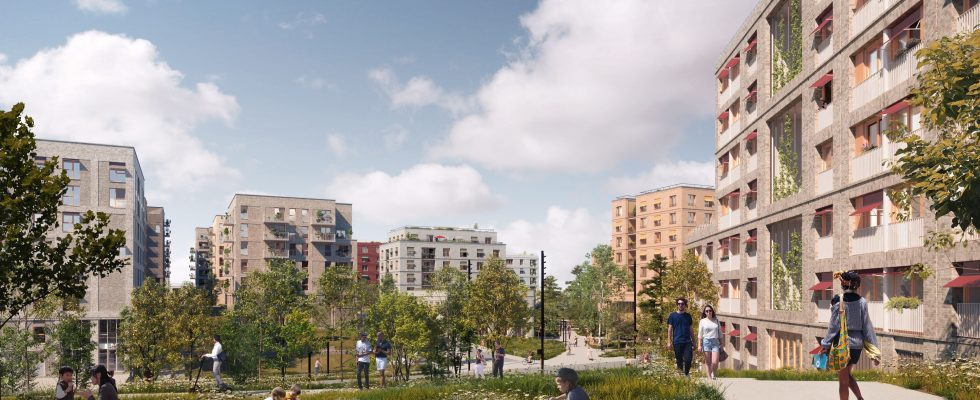In this summer of 2023, behind the palisades and foliage, the buildings that will accommodate 1,500 journalists during the 2024 Olympics are already standing in Dugny (Seine-Saint-Denis). After the event, the “Media Village”, built on the edge of the Parc de la Courneuve, will become a residential area of 1,400 housing units, of which more than 900 will be delivered from March 2024. The rest, developed during the “legacy” phase, is supposed to be transformed into a “garden city of the 21st century”.
“Some 170 media professionals will arrive there from April 1, 2024, before a gradual ramp-up. They will be accommodated in the apartments and will benefit from catering services, a sports hall and dedicated transport”, details Nathalie Poncin, project manager within the Olympic works delivery company (Solideo). Once the journalists have left, the first homes will be handed over to their buyers at the end of 2024.
A forest of buildings
For Dugny, a town of 11,000 inhabitants, it is a question of preparing to welcome… 4,000 more. A major challenge, but also an opportunity, according to Mayor Quentin Gesell (various right). The opportunity to offer citizens a complete “residential course”, while the current stock is made up of 70% social housing. The new real estate programs will offer housing for home ownership, intermediate rental, and only 20% social housing.
Between 4000 and 4700 euros per square meter – against 3083 euros on average in the town – “the prices are quite reasonable for the area”, maintains Philippe Jung, general manager of Demathieu Bard Immobilier, promoter with Sogeprom of the Aire des vents sector, which hosts eight buildings. At the end of June 2023, a quarter of pre-orders came from Dugnysiens and residents of Seine-Saint-Denis.
To the south of the Media Village, the other sector, “Plateau”, occupied by the Manifesto consortium (Ametis, Ideom and Gaïa Promotion), will offer more than 500 housing units as well as 3,000 square meters of ground floor space comprising services, such as a medical centre, and shops (minimarket, restaurants, etc.). Among the public facilities, a school group of 16 classes is also under construction, as well as a gymnasium.
Even built with low-carbon concrete, this forest of buildings does not appeal to everyone. “People like the village side of the town and find the whole thing a little too dense”, admits Dominique Gaulon, first deputy mayor, recalling that the project predates the election of the current municipal team, in 2020. The artificialization of an area of 7 hectares out of the 27 which make up the Aire des Vents in La Courneuve park, former site of the Fête de l’Humanité, is also disputed.
A footbridge reserved for soft mobility
“The population gets used to it, year after year. We try to explain that there will be new amenities,” said the deputy. Among the “pluses” boasted to residents, a footbridge reserved for soft mobility will span the A1 to connect the town of Dugny to Le Bourget. It will facilitate access to the RER and to the secondary school in the area, as well as to the future stations of lines 16 and 17 of the Grand Paris Express, expected for 2026.
“At the same time, the park will be increased by 13 hectares thanks to the depollution of the Terrain des essences, argues Nathalie Poncin. In addition, more than 10,000 trees are planted throughout the Media Village while the roofs and the heart of the future district will be heavily vegetated, thus creating islands of freshness”, she further specifies. The future will tell if in “garden city”, the “garden” aspect has really prevailed over the “city” side…
An article from the special file of L’Express “The new territories of the Olympic Games”
